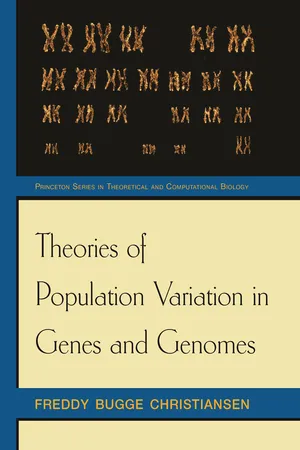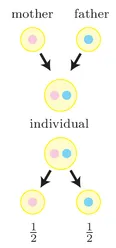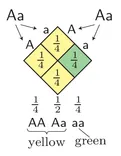![]()
Part I
Genetic Variation
The information in biological inheritance is carried by genes. The genes of an individual human being are copies of genes that his or her parents transmitted through the egg cell and the sperm cell that united to form its original cell. A stretch of DNA sequence on a chromosome in the nucleus of one of our cells traces its origin to a stretch of DNA in either the egg or the sperm that formed us, and from there the ancestral sequences form an unbroken line back through the history of life. The genetic variation in a population of humans therefore originates in the genes transmitted to them from the population of their parents, and we may study the inheritance of the total of the genes carried by the population. Population genetics thus describes the genetic variation in a population and its transmission between generations. The rules of transmission originate in the fundamental laws of inheritance described by Gregor Mendel in 1866. Each individual carries two versions of a particular gene, one from each parent, and they are transmitted according to Mendel’s first law of inheritance, which states that an offspring is equally likely to receive either of the two genes carried by a given parent. An offspring thus receives one version of the gene from each parent, and the gene transmitted by a parent is picked as a random copy of the two versions available. In terms of the life cycle of the individual, as it forms, it receives a version of the gene from each parent, and when it subsequently reproduces, it transmits the gene of maternal origin on average in half of the cases and the paternal gene in the other half.
Mendel’s law lifted to the level of a population of individuals posits that the parental genes each have the same probability of being transmitted to the offspring population. This transmission rule implies conservation of population variation—exactly the property of hereditary transmission that Darwin’s theory of evolution was in need of. Darwin’s theory assumed direct transmission of traits of a character from parents to offspring, but he lacked a mechanism for the maintenance of population variation. Mendel’s law defines biological inheritance as indirect, that is, genes determining a trait and not the trait itself are inherited, and conservation of the heterogeneity within the individual immediately produces conservation of the genetic variability among individuals in a population.
Population genetics, and for that matter genetics, would be topics void of issue without genetic variation, and a basic introduction to the study of genetic variation is offered in Chapter 1 (a short introduction to Mendelian genetics is also offered and a few basic genetic concepts are introduced in Chapter 1—further genetic prerequisites are introduced as needed). Variation abounds and its emergence and decay are main themes in this volume, as is the consequence of genomic structure for the distribution and dynamics of genetic variation. The study and description of variation is therefore an integral part of population genetics, and it commences in Chapter 2.
![]()
Chapter 1
Genetics
Mendel based his description of heredity on experiments with the edible pea,
Pisum sativum. Offspring of a cross between plants from a true-breeding line
1 of yellow peas (first parental line P
1) and one of green peas (P
2) gave yellow offspring (first filial generation F
1) peas in the pods. Selfing plants grown from F
1 peas gave most pods with both yellow and green peas, the F
2 generation. These qualitative results were known among plant breeders, but Mendel contributed a quantitative analysis. The 258 plants grown from the F
1 peas yielded 8023 pea seeds (the F
2 generation), of which 6022 were yellow and 2001 green, and he noted that the observed frequencies were close to
and
, respectively. He made similar observations on six other characters (seed shape, flower color, plant height, …), and having been educated as a mathematician, he placed much emphasis on these simple proportions and devised a model to explain their occurrence.
The F
1 peas in the experiment showed the yellow trait, which is then called the
dominant trait. The green trait was obviously transmitted through the F
1 peas because it reappeared in F
2; as it failed to appear in F
1, it is called the
recessive trait. Mendel hypothesized that the hybrid plants (the F
1 plants) carried determinants for both traits, and that plants from the true-breeding lines only carried determinants (or factors) for one of the traits. The factors are, say,
A and
a, with the capital letter corresponding to the dominant trait. Further, he suggested that hybrid plants transmitted one determinant through pollen and one through the egg cell, and the two determinants of hybrids were transmitted equally often through each type of gamete—egg cell or pollen. The determinants acted like discrete particles. With the additional assumption that gametes unite at random with respect to the determinant carried, the segregation of traits among F
2 peas becomes
and
, the proportions suggested by the experiments.
The key hypothesis of equal segregation from the hybrids was thoroughly tested by Mendel in a series of additional experiments, which are still part of the Mendelian analysis of inheritance. The backcross performs a direct check in that F1 plants are pollinated by individuals from the green recessive line. The seed set is then expected to segregate evenly in the two colors:
The segregation in F2 may be checked by observing the seed set by letting plants grown from F2 peas self-fertilize to form F3. All plants from gr...







